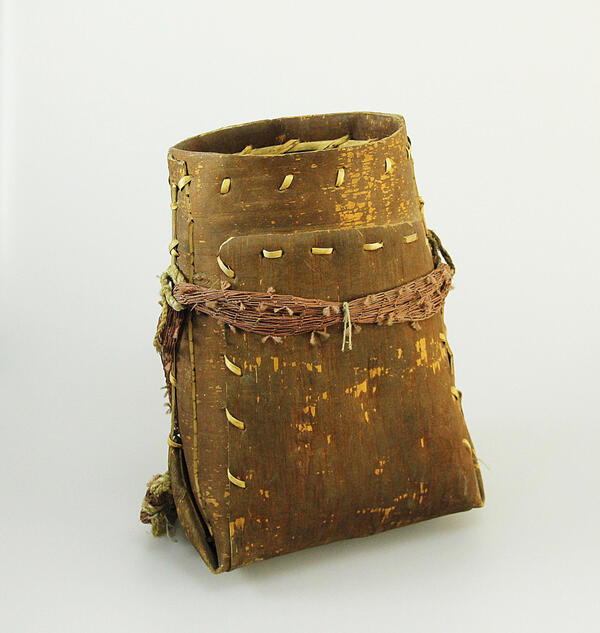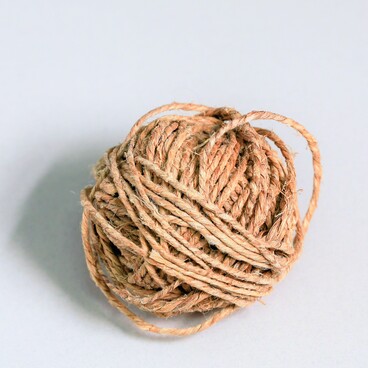Birch bark is one of the most common materials in the traditional Khanty household. It accompanied a man during all his life: babies slept in the birch bark cradles, and the deceased people were wrapped in birch bark at the burial.
Birch bark is the upper layer of birch tree bark. People take birch bark from fallen and dried trees, they don’t harm living birch trees. Despite the fact that the tree could be already rotten, the birch bark remains intact and durable for a long time. This happens thanks to the top layer of the birch bark, which contains a special substance, betulin. It is betulin that colors the trunk in white and protects the bark from external influences.
Nowadays, people know that betulin has antifungal properties. In the old days, of course, this was not known, but women of different nations in the territory of modern Russia noticed that milk, sour cream, butter, meat, and fish could be stored in birch bark vessels for a long time. Bread remained fresh and soft for a long time, and there were no bugs in the flour and cereals. The Khanty also made pots, cylindrical bast baskets and bowls from birch bark.
People also used this material to make baskets and boxes, they were distinguished by their impressive size. The Khanty used such containers for collecting wild berries. For example, two or three buckets of cranberries could fit in one basket.
Unlike homemade wooden and ceramic dishware, birch bark utensils remained in everyday use of the Khanty until the 1960s and the 1970s.
Birch bark is the upper layer of birch tree bark. People take birch bark from fallen and dried trees, they don’t harm living birch trees. Despite the fact that the tree could be already rotten, the birch bark remains intact and durable for a long time. This happens thanks to the top layer of the birch bark, which contains a special substance, betulin. It is betulin that colors the trunk in white and protects the bark from external influences.
Nowadays, people know that betulin has antifungal properties. In the old days, of course, this was not known, but women of different nations in the territory of modern Russia noticed that milk, sour cream, butter, meat, and fish could be stored in birch bark vessels for a long time. Bread remained fresh and soft for a long time, and there were no bugs in the flour and cereals. The Khanty also made pots, cylindrical bast baskets and bowls from birch bark.
People also used this material to make baskets and boxes, they were distinguished by their impressive size. The Khanty used such containers for collecting wild berries. For example, two or three buckets of cranberries could fit in one basket.
Unlike homemade wooden and ceramic dishware, birch bark utensils remained in everyday use of the Khanty until the 1960s and the 1970s.
Women collected birch bark for the manufacture of kitchenware, they also made and decorated utensils. The Khanty tried to extract this material in a mixed forest: they believed that in such forests the bark is thicker, more elastic, and durable.
A large collection of birch bark utensils is housed in the Nefteyugansk Museum Complex. “Ugra Heritage” exhibition presents one of the oldest baskets. This item is made of one large piece of birch bark folded in half with the light side inside. The corners are bent up and fixed with the help of bird cherry side twigs sewn with sarga — birch bark tape. The top shape is held by the inner bird cherry rim, and the bottom is reinforced with a rectangular strip of birch bark. Silk cord straps are placed in the side loops located on the slats.
The item was made in the 1950s. The museum fund obtained this exhibit in August 1998, during a scientific expedition to the Lempino village in the Nefteyugansk District.
A large collection of birch bark utensils is housed in the Nefteyugansk Museum Complex. “Ugra Heritage” exhibition presents one of the oldest baskets. This item is made of one large piece of birch bark folded in half with the light side inside. The corners are bent up and fixed with the help of bird cherry side twigs sewn with sarga — birch bark tape. The top shape is held by the inner bird cherry rim, and the bottom is reinforced with a rectangular strip of birch bark. Silk cord straps are placed in the side loops located on the slats.
The item was made in the 1950s. The museum fund obtained this exhibit in August 1998, during a scientific expedition to the Lempino village in the Nefteyugansk District.



